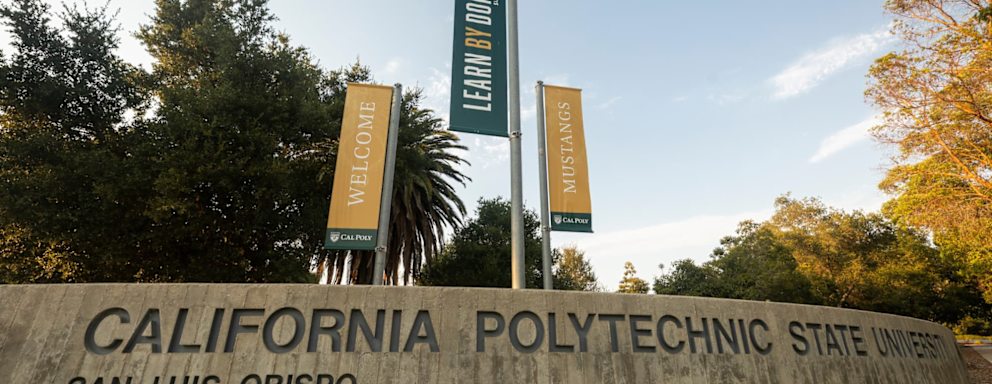What Is a California State Polytechnic University?
 Credit: Image Credit: Joe Johnston/Cal Poly.
Credit: Image Credit: Joe Johnston/Cal Poly.- California has three polytechnic universities: San Luis Obispo, Pomona, and Humboldt.
- Cal Poly Humboldt was designated as a polytechnic institution in 2022.
- A polytechnic university emphasizes in-depth STEM education and technology-based skills training.
California Gov. Gavin Newsom’s big investments in the state’s three polytechnic universities are paying off in surging applications and enrollment.
As part of his administration’s investment in California’s higher education system, Newsom’s most recent budget included a general fund increase of $227 million for the California State University (CSU) system. The 5% increase is part of a multiyear deal made between the Newsom administration and the CSU system which expects institutions to increase California resident enrollment by 1% each year for the next five years.
Newsom likewise previously invested $458 million in his 2021-22 state budget to transform Humboldt State University into California’s third polytechnic university.
Now, applications and enrollment at the new California State Polytechnic University, Humboldt are expected to increase by 50% within three years and 100% within seven years.
California State Polytechnic University, San Luis Obispo, meanwhile, is reporting a record-high number of applications. As of the end of March, the university had 73,113 applications from first-time freshman and transfer students, the San Luis Obispo Tribune reported.
So what is a California polytechnic university and what sets them apart? Here’s what students need to know.
California State Polytechnic University 101
Overseen by the CSU System, the state’s three polytechnic universities focus on “applied learning,” or “the in-depth study found at universities with practical, technology-based skills training.”
The first polytechnic school in the state was founded in 1901 and named California Polytechnic School; it’s now known as California State Polytechnic University, San Luis Obispo, or simply “Cal Poly.” It was brought into the CSU system in 1960 via the Donahoe Higher Education Act, which brought together all state colleges into one system.
The state’s second polytechnic — California State Polytechnic University, Pomona — used to be an extension of Cal Poly but separated from the campus in 1966 and was subsequently granted university status in 1972.
The CSU Board of Trustees in January 2022 designated Humboldt State University as California State Polytechnic University, Humboldt, coinciding with that $458 million funding boost championed by Newsom.
What Sets Polytechnics Apart
Each polytechnic school must offer at least three undergraduate majors in STEM areas: applied sciences, engineering, sciences, and technology.
California polytechnic schools also tend to focus on major selection early, and students are more likely to get a career in a scientific or technical field after graduation.
Admissions are also more selective at polytechnic institutions, and programs are highly ranked nationally compared to similar programs at non-polytechnic institutions. However, tuition rates don’t vary widely between the two types of universities.
For example, Cal Poly requires first-year students to declare a major and complete a corresponding class that same year. The school hosts a well-renowned agriculture program– and has an acceptance rate of just under 30%.
Cal Poly Pomona is known for its engineering programs and has a much higher acceptance rate of around 60%.
Additionally, Cal Poly Humboldt was reported to have an acceptance rate between 85-90%. However, with its new polytechnic designation, an increased number of applications and not enough space is likely to make acceptances less common.
How Did Humboldt State Become a Polytechnic University?
Humboldt State University was chosen to become California’s third polytechnic university because it had the highest percentage of science and natural resource majors in the CSU system and the third-highest percentage of STEM majors overall, falling only behind the two existing polytechnic institutions, according to CSU.
The process to transfer Humboldt from a state university to a polytechnic university began in 2020 and included open forums and planning sessions to determine if it was feasible to make Humboldt a polytechnic institution.
In January 2022, the CSU Board of Trustees formally approved the new designation and the name California Polytechnic University, Humboldt, or Cal Poly Humboldt for short.
As part of the Cal Poly designation, Humboldt received $458 million from the state, with $433 million in one-time investment funds for new academic facilities, building and lab renovations, and more student housing, and $25 million in ongoing funds to support new academic and student programs.
Funding was also needed to get Humboldt to meet CSU’s polytechnic criteria for academic programs and hire faculty to teach the new classes offered.
According to Humboldt, the school is launching at least 12 academic programs in fall 2023 and a total of 27 new academic and experiential programs by 2029. Among the proposed new majors for the latest polytechnic institution are bachelor’s degrees in mechanical and software engineering, data science, cannabis studies, and marine biology.